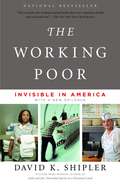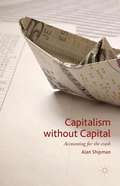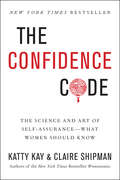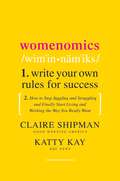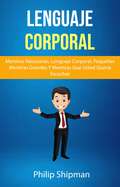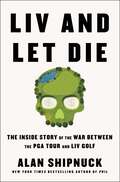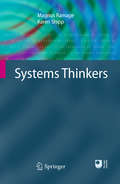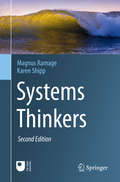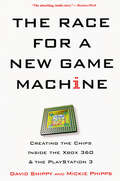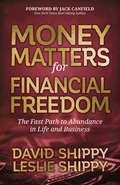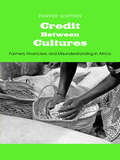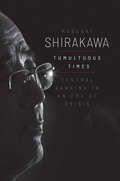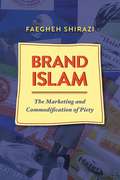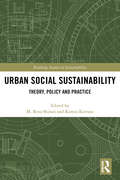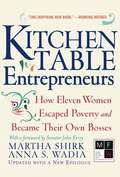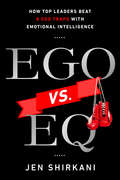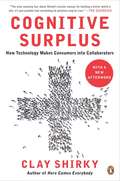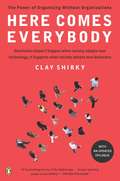- Table View
- List View
The Working Poor: Invisible in America
by David K. ShiplerFrom the author of the Pulitzer Prize–winning Arab and Jew, an intimate portrait unfolds of working American families struggling against insurmountable odds to escape poverty.As David K. Shipler makes clear in this powerful, humane study, the invisible poor are engaged in the activity most respected in American ideology—hard, honest work. But their version of the American Dream is a nightmare: low-paying, dead-end jobs; the profound failure of government to improve upon decaying housing, health care, and education; the failure of families to break the patterns of child abuse and substance abuse. Shipler exposes the interlocking problems by taking us into the sorrowful, infuriating, courageous lives of the poor—white and black, Asian and Latino, citizens and immigrants. We encounter them every day, for they do jobs essential to the American economy. This impassioned book not only dissects the problems, but makes pointed, informed recommendations for change. It is a book that stands to make a difference.
Send
by David Shipley Will SchwalbeThe Essential Guide to Email for Office and Home bull; When should you email, and when should you call, fax, or just show up? bull; What is the crucial-and most often overlooked-line in an email? bull; What is the best strategy when you send (in anger or error) a potentially career-ending electronic bombshell? Enter Send. Whether you email just a little or never stop, here, at last, is an authoritative book that shows how to write the perfect email anywhere. Send also points out the numerous (but not always obvious) times when email can be the worst option and might land you in hot water (or even jail!). The secret is, of course, to think before you click. Send is nothing short of a survival guide for the digital age-wise, brimming with good humour, and filled with helpful lessons from the authors' own email experiences (and mistakes). In short: absolutely e-essential.
Send: The Essential Guide to Email for Office and Home
by David Shipley Will SchwalbeThe hows and whys of using email, and how to communicate effectively.
Capitalism without Capital
by Alan ShipmanAn unusual consensus has developed among economists that the 'long boom' before 2008, and the subsequent crisis and recession, resulted from a global excess of capital. Over-supply of saving drive down capital costs, encouraging excessively risky investment and preventing the scrapping of outmoded plant. Capital's inexorable growth is also blamed for a prolonged squeeze on wages, rising elite wealth and worsening global inequality. This book explores the obvious clash between such argumentsand actual measurements of capital, which show a small and shrinking 'productive' component, and a deepening disconnection between capital accumulation and economic growth. It traces the conflict to the continued absence of consistent definitions or measurements of capital, and neglect of the complex connection between aggregate capital and wealth. Capital 'gains' and 'losses', and the growing domination of income statements by balance sheets, undermine attempts to sidestep the problem by reconstituting economics as a system of flows.
The Market Revolution and its Limits: A Price for Everything
by Alan ShipmanThe Market Revolution and its limits summarises why many economists believe that markets are best. It explores how even 'market failures' can be given market solutions, and asks why market ideas seem to have taken such a firm hold. Non-polemical in its approach, this book provides a comprehensive appraisal of the market and its alternatives, backed up with empirical international illustrations. Shipman concludes that the 'revolution' lies in redefining the market process rather than the market outcome.
Transcending Transaction: The Search for Self-Generating Markets (Routledge Frontiers Of Political Economy Ser. #Vol. 35)
by Alan ShipmanTranscending Transaction examines recent attempts to show how, in theory and history, market transaction can emerge from the unregulated interaction of competitive traders. Alan Shipman examines the legal, informational, organisational, social and financial foundations of market trade, focusing on the possible routes by which it could arise without
The Confidence Code: The Science and Art of Self-Assurance---What Women Should Know
by Claire Shipman Katty KayConfidence. We want it. We need it. But it can be maddeningly enigmatic and out of reach. The authors of the New York Times bestseller Womenomics deconstruct this essential, elusive, and misunderstood quality and offer a blueprint for bringing more of it into our lives.Is confidence hardwired into the DNA of a lucky few--or can anyone learn it? Is it best expressed by bravado, or is there another way to show confidence? Which is more important: confidence or competence? Why do so many women, even the most successful, struggle with feelings of self-doubt? Is there a secret to channeling our inner confidence?In The Confidence Code, journalists Katty Kay and Claire Shipman travel to the frontiers of neuroscience on a hunt for the confidence gene and reveal surprising new research on its roots in our brains. They visit the world's leading psychologists who explain how we can all chose to become more confident simply by taking action and courting risk, and how those actions change our physical wiring. They interview women leaders from the worlds of politics, sports, the military, and the arts to learn how they have tapped into this elemental resource. They examine how a lack of confidence impacts our leadership, success, and fulfillment.Ultimately, they argue, while confidence is partly influenced by genetics, it is not a fixed psychological state. That's the good news. You won't discover it by thinking positive thoughts or by telling yourself (or your children) that you are perfect as you are. You also won't find it by simply squaring your shoulders and faking it. But it does require a choice: less people pleasing and perfectionism and more action, risk taking, and fast failure.Inspiring, insightful, and persuasive, The Confidence Code shows that by acting on our best instincts and by daring to be authentic, women can feel the transformative power of a life on confidence.
Womenomics
by Claire Shipman Katty KayYou are not alone. Finally, here is a book that gets to the heart of what professional women want. You've probably been loath to admit it, but like most of us, you have had enough of the sixty-hour workweeks, the day-care dash, and the vacations that never get taken. You don't want to quit, you want to work--but on your own terms and in ways that make it possible to have a life as well. Women have power. In Womenomics, journalists Shipman and Kay deal in facts, not stereotypes, providing a fresh perspective on the largely hidden power that women have in today's marketplace. Why? Companies with more women managers are more profitable. Women do more of the buying. A talent shortage looms. Younger generations want to work flexibly, too. It all adds up to a workplace revolution that is great news for professional women--not to mention men and businesses as well. As Brenda Barnes, CEO of Sara Lee, notes: "Companies need to recognize that this kind of flexibility offers employees the ability to manage and balance their own careers and lives, which in turn improves productivity and employee morale." This new way of thinking and working is all the more valuable in a recession, as companies begin offering flexible schedules, four-day workweeks, and extended vacations as a way to avoid layoffs, save costs, and still reward employees. It is personal. Womenomics does more than marshal the evidence of this historic shift. It also shows women how to redefine success, be productive, and build satisfying careers that don't require an all-or-nothing lifestyle. Most appealing are the candid personal anecdotes from Shipman's and Kay's own experiences and the stories they have gathered from professional women around the country who are coping with the same issues. It is possible. Shipman and Kay don't waste time on what women can't do or can't have. Instead, they show women how to chart an empowering, exhilarating course to a richer life. Inspiring, practical, and persuasive, Womenomics offers a groundbreaking blueprint for changing the way you live and work--with advice, guidance, and fact-based support that proves you don't have to do it all to have it all.
Lenguaje Corporal: Ganar Atracción A Través Del Lenguaje Corporal
by Harvey ShipmanEstudios realizados por zoólogos y conductistas revelaron que tanto los machos como las hembras utilizan un número de complejos gestos a la hora de cortejar. Algunos de ellos resultan muy evidentes, mientras que otros están ocultos; y la mayoría de ellos son inconscientes. A la concusión que se llegó fue que el ritual del cortejo de los humanos no es muy diferente del de los animales. La tarea es demostrar los gestos de cortejo específicos del sexo de uno a una pareja potencial. Aquellos que estén interesados le responderán con gestos acordes o con señales de cortejo, y le harán saber de manera no verbal que usted les gusta.
Lenguaje Corporal: Mentiras Necesarias, Lenguaje Corporal, Pequeñas Mentiras Grandes Y Mentiras Que Usted Quería Escuchar
by Philip ShipmanComo una especie de comunicación no verbal, el lenguaje corporal es necesario para comunicar pensamientos, sentimientos e intenciones a través de la expresión facial, el tacto, el movimiento de los ojos, gestos y la postura corporal. El lenguaje corporal no es un lenguaje de señas, pero es un lenguaje completo utilizado para comunicar y entender los sentimientos e intenciones de los miembros de su familia y colegas. El lenguaje corporal no utiliza interpretación ni gramática. El significado del lenguaje corporal puede depender del movimiento particular. En cada sociedad se utiliza un comportamiento particular para la interpretación del lenguaje corporal. Si quieres aprender lenguaje corporal, este libro puede serte útil. "Madres difíciles de sanar: relaciones tóxicas con madres narcisistas; como entender y superar para siempre". Nos guste o no, la relación que tenemos con nuestras madres tendrá un efecto a largo plazo en nuestra vida. Influye en nuestro comportamiento, nuestra personalidad y nuestra autoestima. Es mi deseo que a pesar de la relación negativa que estás teniendo con tu madre, podamos manipularla y ofrecerte un legado positivo y una mejor relación con tu madre. Veremos cómo adaptarnos a las características específicas que exhibe una madre narcisista.
LIV and Let Die: The Inside Story of the War Between the PGA Tour and LIV Golf
by Alan ShipnuckAlan Shipnuck, the New York Times bestselling author of Phil, returns with a major new work of insider reporting on the battle for the soul of professional golf between the PGA Tour and the Saudi-funded LIV Golf League.Over the past two years, professional golf has been at war, and Alan Shipnuck has been our most trusted correspondent on the front lines. Following closely on the heels of his bestselling sensation Phil, Shipnuck turns to the conflict that made Mickelson, and many other top golfers, villainous in the eyes of the public: LIV Golf&’s controversial—and belligerent—storming of the professional golf world. (LIV&’s unofficial motto, immortalized on hats gifted at a staff party: &“Fuck &’Em All.&”) In LIV and Let Die, Shipnuck delivers the inside story in real time, with fly-on-the-wall reporting from the yachts where LIV was hatched and within the corridors of power as the PGA Tour flailed to fend off the threat. Shipnuck has traveled seamlessly between both tours—having countless conversations with players, caddies, CEOs, agents, financiers, lawyers, flaks, fans, and Instagramming wives—to deliver a no-holds-barred account of the most chaotic moment in golf history. Anyone who has a stake in professional golf lined up for an interview with Shipnuck—because they knew everyone else was talking to him, too. The disruption to an old, proud sport was largely conducted in the shadows, but LIV and Let Die delivers numerous revelations about what really happened, and why. Shipnuck&’s unparalleled access and award-winning reporting chops provide rich portraits of the brand names at the center of this sprawling tableau: Greg Norman, Rory McIlroy, Brooks Koepka, Tiger Woods, Jack Nicklaus, Jay Monahan, His Excellency Yasir Al-Rumayyan, Donald Trump, Saudi Crown Prince Mohammed bin Salman, Dustin (and Paulina!) Johnson, Pat (and Ashley!) Perez, Patrick (and Justine!) Reed, Bryson DeChambeau, Jimmy Dunne, and many more. Bankrolled by Saudi Arabia&’s Public Investment Fund, LIV Golf has upended the men&’s professional game with vast riches—blatant &“sportswashing,&” from the mouth of Mickelson himself. Says Brandel Chamblee, &“I think the LIV players are in a morally indefensible position, with a willful blindness to the consequences of their action, making them complicit to the ongoing atrocities.&” Rory McIlroy said of playing a tournament alongside LIV golfers, &“It&’s going to be hard for me to stomach.&” But the battle to thwart LIV revealed a deeper struggle within the game. &“The Seminole guys, the Augusta National guys, they&’re used to having all the power in the golf world,&” says LIV&’s Peter Uihlein. &“They don&’t like to be challenged. They&’re not used to it.&” The bitter feuding (and trolling) between the PGA loyalists and the LIV camp made the battle between the tours deeply personal—but for the top leaders of the two tours it was strictly business, and in a series of secret meetings they reshaped the future of the sport. LIV and Let Die provides the previously unknown background and crucial context to understand the armistice between the tours that shocked the world in June 2023. Long known as the most fearless writer on the golf beat, Shipnuck has delivered another hotly anticipated book packed with juicy nuggets and in-the-room-where-it-happened action...think Bob Woodward moonlighting on the sports desk. LIV and Let Die is the definitive account of the biggest (non-Tiger) golf story this century and a lively page-turner that in places reads like a spy thriller.
Systems Thinkers
by Karen Shipp Magnus RamageThis book presents a biographical history of the field of systems thinking, by examining the life and work of thirty of its major thinkers. It discusses each thinker's key contributions, the way this contribution was expressed in practice and the relationship between their life and ideas. This discussion is supported by an extract from the thinker's own writing, to give a flavour of their work and to give readers a sense of which thinkers are most relevant to their own interests.
Systems Thinkers
by Karen Shipp Magnus RamageThis book presents a biographical history of the field of systems thinking, by examining the life and work of thirty of its major thinkers. It discusses each thinker’s key contributions, the way this contribution was expressed in practice and the relationship between their life and ideas. This discussion is supported by an extract from the thinker’s own writing, to give a flavour of their work and to give readers a sense of which thinkers are most relevant to their own interests.
The Race For A New Game Machine
by David Shippy Mickie PhippsA fast-paced tell-all. . .one of the great business stories of our young century.--Steve Cherry, IEEE Spectrum Magazine The Xbox 360 and PlayStation 3 game systems have changed the face of home entertainment. But few know the amazing story inside the consoles--how David Shippy and his team of engineers at the Sony/Toshiba/IBM Design Center (STI) forged the tiny miracle at the core of it all: a revolutionary microprocessor chip that set a new paradigm in personal computing. At stake were the livelihoods--and sanity--of an unsung group of tireless visionaries. At war were the giants Microsoft and Sony. "Drama and secret deals. . . This is the real deal."--Bob Molyneaux, ChipBridge Here is a dazzling, behind-the-scenes account of life in the tech world, featuring memorable characters, high-level corporate intrigue, and cutthroat business dealings. It's a story that's never been told--until now. "The real story of a team of people tasked with doing the impossible."--John C. Beck, author of Got Game "Remarkable. . .fascinating."--Dean Takahashi, author of Opening the Xbox "The story of the whole effort to build the Cell."--The Wall Street Journal
Money Matters for Financial Freedom: The Fast Path to Abundance in Life and Business
by David Shippy Leslie ShippyMoney Matters for Financial Freedom provides a roadmap for achieving financial freedom in less than five years!David and Leslie Shippy went from a middle-class life to financial freedom in three short years. They were able to replace both of their multiple six-figure incomes and walk away from corporate America. Their first three apartment investments tripled their investors&’ money. They have since gone on to purchase and manage a portfolio of apartments that consists of over 3000 units and is worth over $300 million. Money Matters for Financial Freedom reveals the principles they used to do so.David and Leslie&’s detailed guide provides specific examples and skills that shift readers&’ thinking from a middle-class mindset to a financially free millionaire mindset. It outlines specific techniques and leadership skills necessary for running a multimillion-dollar business, along with step-by-step examples of how to manage money, create multiple business streams of income, and enable financial freedom!
Credit Between Cultures: Farmers, Financiers, and Misunderstanding in Africa
by Parker ShiptonParker Shipton brings a variety of perspectives--cultural, economic, political, and religious-philosophical--and years of field experience to this fascinating study about people who borrow and lend in the interior of Africa. His conclusions challenge the conventional wisdom of the past half century (including perennial World Bank orthodoxy) about the need for credit among African farming people.
Social Stratification in an Aging Society with Low Fertility: The Case of Japan (Economy and Social Inclusion)
by Sawako ShirahaseThis edited book empirically discusses stratification in contemporary Japanese society. It is unique for its examination of social inequality in relation to declining fertility and an aging population. Japan is the most aged society in the world: according to the Statistics Bureau of Japan, people who are aged 65 and above comprised 29.1% of the country’s total population in 2021. Meanwhile, the fertility rate has continuously declined since the mid-1970s. Japan experienced a dramatic change in its demographic structure in a short period of time. Such fast change could be a major factor that generated social stratification. In her industrialization, Japan was thought to share a pattern of social stratification similar to that of developed European and North American countries but with a low degree of socio-economic inequality and a high degree of homogeneity. There is no clear support for this description of Japan, although the country does share a pattern and degree of social stratification similar to that observed in Europe and North America. The social stratification theory has been developed in close relationship to the labor market; however, it is necessary to further examine the social stratification of very aged societies in which a substantial number of the population—namely, retired persons—no longer have any ties to the labor market. In this book, the contributors explore the pattern of social stratification at three life stages: young, middle-aged, and elderly. Included are discussions of various aspects of stratification such as education, work, wealth, marriage, family, gender, generation, and social attitudes.
Tumultuous Times: Central Banking in an Era of Crisis (Yale Program on Financial Stability Series)
by Masaaki ShirakawaA rare insider&’s account of the inner workings of the Japanese economy, and the Bank of Japan&’s monetary policy, by a career central banker The Japanese economy, once the envy of the world for its dynamism and growth, lost its shine after a financial bubble burst in early 1990s and slumped further during the Global Financial Crisis in 2008. It suffered even more damage in 2011, when a severe earthquake set off the Fukushima Daiichi nuclear disaster. However, the Bank of Japan soldiered on to combat low inflation, low growth, and low interest rates, and in many ways it served as a laboratory for actions taken by central banks in other parts of the world. Masaaki Shirakawa, who led the bank as governor from 2008 to 2013, provides a rare insider&’s account of the workings of Japanese economic and monetary policy during this period and how it challenged mainstream economic thinking.
Brand Islam: The Marketing And Commodification Of Piety
by Faegheh ShiraziFrom food products to fashions and cosmetics to children’s toys, a wide range of commodities today are being marketed as “halal” (permitted, lawful) or “Islamic” to Muslim consumers both in the West and in Muslim-majority nations. <P><P>However, many of these products are not authentically Islamic or halal, and their producers have not necessarily created them to honor religious practice or sentiment. Instead, most “halal” commodities are profit-driven, and they exploit the rise of a new Islamic economic paradigm, “Brand Islam,” as a clever marketing tool. <P><P> Brand Islam investigates the rise of this highly lucrative marketing strategy and the resulting growth in consumer loyalty to goods and services identified as Islamic. Faegheh Shirazi explores the reasons why consumers buy Islam-branded products, including conspicuous piety or a longing to identify with a larger Muslim community, especially for those Muslims who live in Western countries, and how this phenomenon is affecting the religious, cultural, and economic lives of Muslim consumers. <P><P>She demonstrates that Brand Islam has actually enabled a new type of global networking, joining product and service sectors together in a huge conglomerate that some are referring to as the Interland. <P><P>A timely and original contribution to Muslim cultural studies, Brand Islam reveals how and why the growth of consumerism, global communications, and the Westernization of many Islamic countries are all driving the commercialization of Islam.
Urban Social Sustainability: Theory, Policy and Practice (Routledge Studies in Sustainability)
by M. Shirazi Ramin KeivaniThis ground breaking volume raises radical critiques and proposes innovative solutions for social sustainability in the built environment. Urban Social Sustainability provides an in-depth insight into the discourse and argues that every urban intervention has a social sustainability dimension that needs to be taken into consideration, and incorporated into a comprehensive and cohesive ‘urban agenda’ that is built on three principles of recognition, integration, and monitoring. This should be achieved through a dialogical and reflexive process of decision-making. To achieve sustainable communities, social sustainability should form the basis of a constructive dialogue and be interlinked with other areas of sustainable development. This book underlines the urgency of approaching social sustainability as an urban agenda and goes on to make suggestions about its formulation. Urban Social Sustainability consists of original contributions from academics and experts within the field and explores the significance of social sustainability from different perspectives. Areas covered include urban policy, transportation and mobility, urban space and architectural form, housing, urban heritage, neighbourhood development, and urban governance. Drawing on case studies from a number of countries and world regions the book presents a multifaceted and interdisciplinary understanding from social sustainability in urban settings, and provides practitioners and policy makers with innovative recommendations to achieve more socially sustainable urban environment.
Kitchen Table Entrepreneurs: How Eleven Women Escaped Poverty and Became Their Own Bosses
by Martha Shirk Anna S. WadiaOver the last five years, the number of women-owned businesses has grown at twice the rate of all U. S. firms; in the next few years, the number is expected to surpass the six million mark. Kitchen Table Entrepreneurs tells the inspirational stories of eleven low-income women who have marshaled the creative energy, confidence, and capital necessary to start their own small businesses. These women, who have used their entrepreneurial skills as a route out of poverty, give an American face to an economic empowerment tool that has enjoyed great success in developing countries. By becoming their own bosses, they not only provide for their children but also inspire them. Though each of their businesses is unique, all eleven of these women have discovered previously unknown strengths as they've struggled to overcome personal and bureaucratic obstacles. All received important assistance from nonprofit organizations supported by the Ms. Foundation for Women, the pioneer funding entity of microenterprise programs in the United States. Updated with a new epilogue.
The Political Logic of Economic Reform in China (California Series on Social Choice and Political Economy #24)
by Susan L. ShirkIn the past decade, China was able to carry out economic reform without political reform, while the Soviet Union attempted the opposite strategy. How did China succeed at economic market reform without changing communist rule? Susan Shirk shows that Chinese communist political institutions are more flexible and less centralized than their Soviet counterparts were.Shirk pioneers a rational choice institutional approach to analyze policy-making in a non-democratic authoritarian country and to explain the history of Chinese market reforms from 1979 to the present. Drawing on extensive interviews with high-level Chinese officials, she pieces together detailed histories of economic reform policy decisions and shows how the political logic of Chinese communist institutions shaped those decisions.Combining theoretical ambition with the flavor of on-the-ground policy-making in Beijing, this book is a major contribution to the study of reform in China and other communist countries.
EGO vs. EQ: How Top Business Leaders Beat 8 Ego Traps with Emotional Intelligence
by Jen ShirkaniIn EGO vs. EQ, Jen Shirkani shares strategies for using emotional intelligence (EQ) as a tool to avoid career derailment. The executive leadership failure rate is high: two in five CEOs fail in the first eighteen months on the job. This book teaches you how to identify the most common reasons for leadership ineffectiveness, and provides tools to raise your EQ, prevent leadership lapses, and avoid the cascading consequences they can produce. Drawing on real-life anecdotes from the author's twenty years of coaching and consulting, including stories of success and failure from the leaders of vanguard companies in energy, investment, and health care industries, Ego vs. EQ provides research and case study examples in an easy to read, practical format and is ideal for anyone currently in an executive leadership role, including business owners, and those wanting to become a dynamic leader in the future.
Cognitive Surplus
by Clay ShirkyThe author of the breakout hit Here Comes Everybody reveals how new technology is changing us for the better. In his bestselling Here Comes Everybody, Internet guru Clay Shirky provided readers with a much-needed primer for the digital age. Now, with Cognitive Surplus, he reveals how new digital technology is unleashing a torrent of creative production that will transform our world. For the first time, people are embracing new media that allow them to pool their efforts at vanishingly low cost. The results of this aggregated effort range from mind-expanding reference tools like Wikipedia to life-saving Web sites like Ushahidi.com, which allows Kenyans to report acts of violence in real time. Cognitive Surplus explores what's possible when people unite to use their intellect, energy, and time for the greater good.
Here Comes Everybody: The Power of Organizing Without Organizations
by Clay ShirkyClay Shirky's international bestseller Here Comes Everybody: How Change Happens When People Come Together explores how the unifying power of the internet is changing the character of human society. Welcome to the new future of involvement. Forming groups is easier than it's ever been: unpaid volunteers build Wikipedia together in their spare time, mistreated customers can join forces to get their revenge on airlines and high street banks, and one man with a laptop can raise an army to help recover a stolen phone. The results of this new world of easy collaboration can be both good (young people defying an oppressive government with a guerrilla ice-cream eating protest) and bad (girls sharing advice for staying dangerously skinny) but it's here and, as Clay Shirky shows, it's affecting. . . well, everybody. For the first time, we have the tools to make group action truly a reality. And they're going to change our whole world. 'As crisply argued and as enlightening a book about the internet as has been written' Daily Telegraph 'As usable as the technology he writes about' Independent 'Clay Shirky's masterpiece . . . glittering, brilliant insights that make me think, yes, of course, that's how it all works' Cory Doctorow, co-editor of Boing Boing 'Anyone interested in the vitality and influence of groups of human beings - from knitting circles, to political movements, to multinational corporations - needs to read this book' Steven Johnson, author of Everything Bad is Good for You and Emergence Clay Shirky writes, teaches, and consults on the social and economic effects of the internet. A professor at NYU's Interactive Telecommunications Program, he has consulted for Nokia, Procter and Gamble, News Corp. , the BBC, the US Navy, and Lego. Over the years, his writings have appeared in The New York Times, the Wall Street Journal, the Harvard Business Review, Wired, and IEEE Computer.
